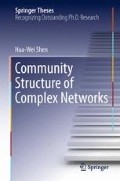Abstract
In this chapter, we explore various types of structural regularities in networks. For this aim, we divide network nodes into groups such that the members of each group have similar patterns of connections to other groups. Then, we leverage generative model to describe network structure. The structural regularities are then naturally obtained by statistical inference using expectation maximization algorithm. The most prominent strength of our model is the high flexibility, which enables it to possess the advantages of existing models and to overcome their shortcomings in a unified way. Not only can broad types of structure be detected without prior knowledge of the type of intrinsic regularities existing in the target network, but also the type of identified structure can be directly learned from the network. Our model outperforms the state-of-the-art model in shedding light on various structural regularities of networks, which are beyond the capability of existing models.
Access this chapter
Tax calculation will be finalised at checkout
Purchases are for personal use only
Notes
- 1.
Since this network is an undirected network, the two kinds of belonging coefficient are identical, i.e., α ir =β ir .
References
Girvan, M., Newman, M.E.J.: Community structure in social and biological networks. Proc. Natl. Acad. Sci. USA 99, 7821–7826 (2002)
Newman, M.E.J.: The structure and function of complex networks. SIAM Rev. 45, 167–256 (2003)
Flake, G.W., Lawrence, S.R., Giles, C.L., Coetzee, F.M.: Self-organization and identification of Web communities. IEEE Comput. 35, 66–71 (2002)
Cheng, X.Q., Ren, F.X., Zhou, S., Hu, M.B.: Triangular clustering in document networks. New J. Phys. 11, 033019 (2009)
Guimerà, R., Amaral, L.A.N.: Functional cartography of complex metabolic networks. Nature 433, 895–900 (2005)
Cheng, X.Q., Ren, F.X., Shen, H.W., Zhang, Z.K., Zhou, T.: Bridgeness: A local index on edge significance in maintaining global connectivity. J. Stat. Mech. P10011 (2010)
Newman, M.E.J., Girvan, M.: Finding and evaluating community structure in networks. Phys. Rev. E 69, 026113 (2004)
Newman, M.E.J.: Finding community structure in networks using the eigenvectors of matrices. Phys. Rev. E 74, 036104 (2006)
Ramasco, J.J., Mungan, M.: Inversion method for content-based networks. Phys. Rev. E 77, 036122 (2008)
Vazquez, A.: Population stratification using a statistical model on hypergraphs. Phys. Rev. E 77, 066106 (2008)
Ren, W., Yan, G.Y., Liao, X.P., Xiao, L.: Simple probabilistic algorithm for detecting community structure. Phys. Rev. E 79, 036111 (2009)
Zhang, H.Z., Qiu, B.J., Giles, C.L., Foley, H.C., Yen, J.: An lda-based community structure discovery approach for large-scale social networks. In: Proceedings of the IEEE Conference on Intelligence and Security Informatics, pp. 200–207 (2007)
Clauset, A., Moore, C., Newman, M.E.J.: Hierarchical structure and the prediction of missing links in networks. Nature 453, 98–101 (2008)
Newman, M.E.J., Leicht, E.A.: Mixture models and exploratory analysis in networks. Proc. Natl. Acad. Sci. USA 104, 9564–9569 (2007)
Karrer, B., Newman, M.E.J.: Stochastic blockmodels and community structure in networks. Phys. Rev. E 83, 016107 (2011)
Airoldi, E.M., Blei, D.M., Fienberg, S.E., Xing, E.P.: Mixed membership stochastic blockmodels. J. Mach. Learn. Res. 9, 1981–2014 (2008)
Newman, M.E.J., Strogatz, S.H., Watts, D.J.: Random graphs with arbitrary degree distributions and their applications. Phys. Rev. E 64, 026118 (2001)
Ball, B., Karrer, B., Newman, M.E.J.: Efficient and principled method for detecting communities in networks. Phys. Rev. E 84, 036103 (2011)
Shen, H.W., Cheng, X.Q., Guo, J.F.: Exploring the structural regularities in networks. Phys. Rev. E 84, 056111 (2011)
Zachary, W.W.: An information flow model for conflict and fission in small groups. J. Anthropol. Res. 33, 452–473 (1977)
Rosvall, M., Bergstrom, C.T.: An information-theoretic framework for resolving community structure in complex networks. Proc. Natl. Acad. Sci. USA 104, 7327–7331 (2007)
Szell, M., Lambiotte, R., Thurner, S.: Multirelational organization of large-scale social networks in an online world. Proc. Natl. Acad. Sci. USA 107, 13636–13641 (2010)
Heider, F.: Attitudes and cognitive organization. J. Psychol. 21, 107–112 (1946)
Marvel, S.A., Kleinberg, J., Kleinberg, R.D., Strogatz, S.H.: Continuous-time model of structural balance. Proc. Natl. Acad. Sci. USA 108, 1771–1776 (2011)
Gómez, S., Jensen, P., Arenas, A.: Analysis of community structure in networks of correlated data. Phys. Rev. E 80, 016114 (2009)
Traag, V.A., Bruggeman, J.: Community detection in networks with positive and negative links. Phys. Rev. E 80, 036115 (2009)
Rubinov, M., Sporns, O.: Weight-conserving characterization of complex functional brain networks. NeuroImage 56, 2068–2079 (2011)
Yang, B., Cheung, W.K., Liu, J.M.: Community mining from signed social networks. IEEE Trans. Knowl. Data Eng. 19, 1333–1348 (2007)
Lusseau, D., Schneider, K., Boisseau, O.J., Haase, P., Slooten, E., Dawson, S.M.: The bottlenose dolphin community of Doubtful Sound features a large proportion of long-lasting associations. Can geographic isolation explain this unique trait? Behav. Ecol. Sociobiol. 54, 396–405 (2003)
Guimerà, R., Sales-Pardo, M., Amaral, L.A.N.: Module identification in bipartite and directed networks. Phys. Rev. E 76, 036102 (2007)
Kropivnik, S., Mrvar, A.: An analysis of the Slovene parliamentary parties network. In: Developments in Statistics and Methodology, pp. 209–216 (1996)
Doreian, P., Mrvar, A.: A partitioning approach to structural balance. Soc. Netw. 18, 149–168 (1996)
Author information
Authors and Affiliations
Rights and permissions
Copyright information
© 2013 Springer-Verlag Berlin Heidelberg
About this chapter
Cite this chapter
Shen, HW. (2013). Exploratory Analysis of the Structural Regularities in Networks. In: Community Structure of Complex Networks. Springer Theses. Springer, Berlin, Heidelberg. https://doi.org/10.1007/978-3-642-31821-4_5
Download citation
DOI: https://doi.org/10.1007/978-3-642-31821-4_5
Publisher Name: Springer, Berlin, Heidelberg
Print ISBN: 978-3-642-31820-7
Online ISBN: 978-3-642-31821-4
eBook Packages: Computer ScienceComputer Science (R0)

